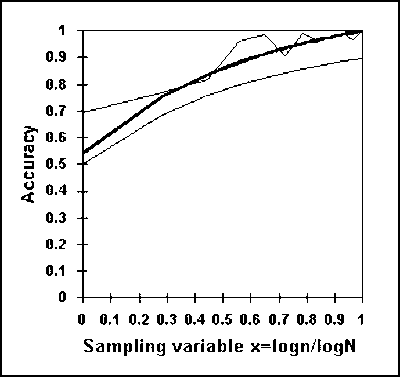The propositions and conclusions relating to geometrical boundaries for the accuracy curves of finite populations can be easily expanded and adapted to populations of infinite size. We start with the observation that when the population size N increases indefinitely, the parameter a given in (5.22) and based on expressions (5.20) and (5.21), takes the following limit values:
Population can be concave
|
|
(8.1) |
Population cannot be concave
|
|
(8.2) |
Thus, the pessimistic accuracy curve
 for an infinite population
should be intercepting the A-axis at an accuracy value
for an infinite population
should be intercepting the A-axis at an accuracy value
 defined by (8.1) or (8.2).
Furthermore and since the population is infinite, the pessimistic accuracy
curves, rather than having a maximum value 1 corresponding to a complete
enumeration of the population elements, should be approaching the line
defined by (8.1) or (8.2).
Furthermore and since the population is infinite, the pessimistic accuracy
curves, rather than having a maximum value 1 corresponding to a complete
enumeration of the population elements, should be approaching the line
 in an asymptotic manner. It
is easy to verify that the model:
in an asymptotic manner. It
is easy to verify that the model:
|
|
(8.3) |
satisfies the two conditions described above. The parameter
 is a function of n
and defined as:
is a function of n
and defined as:
|
|
(8.4) |
where, as in the case of a finite population, the primary
parameter  and its three
derivatives
and its three
derivatives  have been
computed as:
have been
computed as:
Population can be concave
|
|
(8.5) |
Population cannot be concave
|
|
(8.6) |
Formulae for a, g and S
|
|
(8.7) |
|
|
(8.8) |
|
|
(8.9) |
For large populations the two models described by the
functions (7.5) and (8.3) give approximately the same results with the latter
being more optimistic to the left and more pessimistic to the right of the
critical sample size  .
However, the model for infinite populations applies rather poorly to populations
of small size since it computes pessimistic accuracy values well below those
given by (7.5). Figures 8.1 and 8.2 illustrate these observations for two convex
populations with sizes N=12 and N=1000. The limit curves
A_(x) are described by a darker line while the thin lines correspond to
the application of the function
.
However, the model for infinite populations applies rather poorly to populations
of small size since it computes pessimistic accuracy values well below those
given by (7.5). Figures 8.1 and 8.2 illustrate these observations for two convex
populations with sizes N=12 and N=1000. The limit curves
A_(x) are described by a darker line while the thin lines correspond to
the application of the function
 .
.
Fig. 8.1. The two limit curves for a convex population with N=12

Fig. 8.2. The two limit curves for a convex population with N=1000
